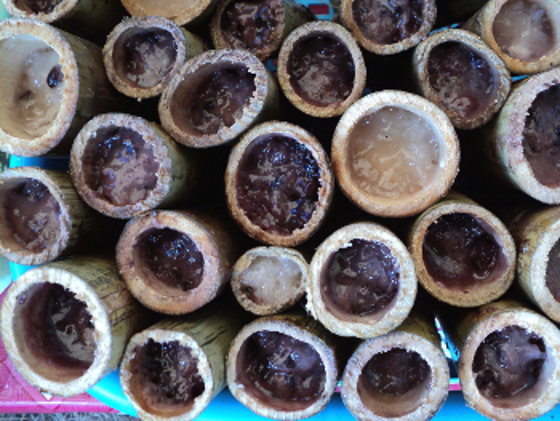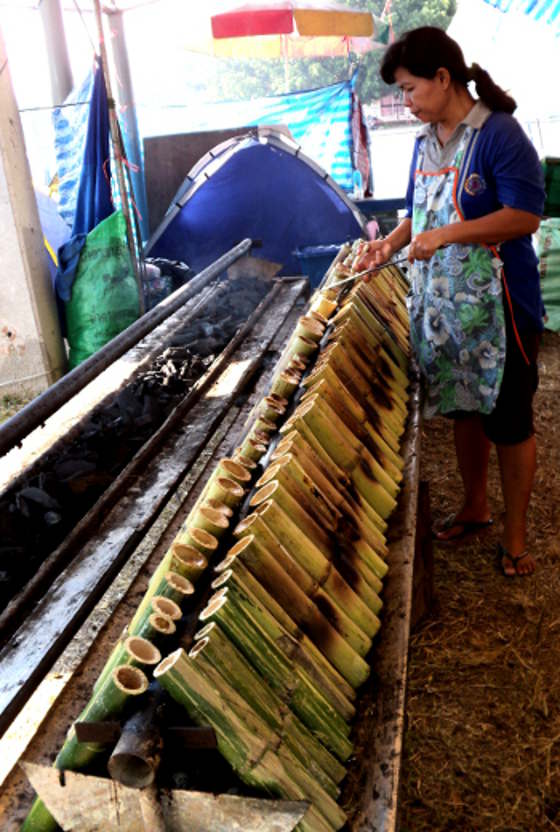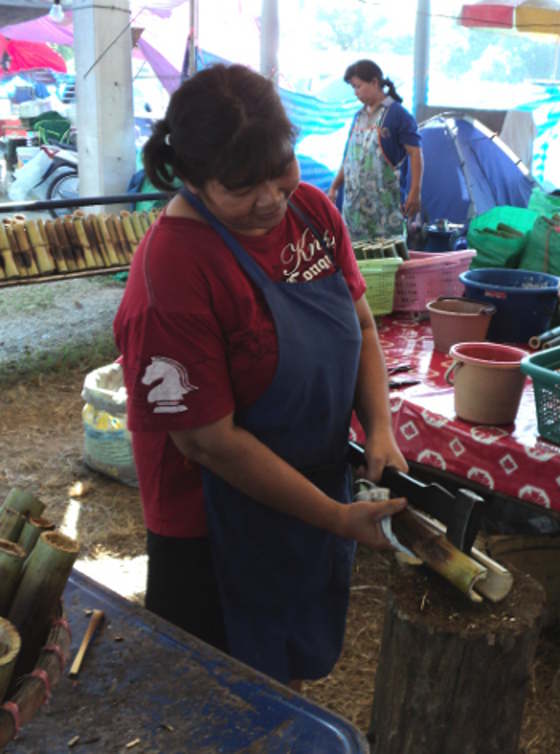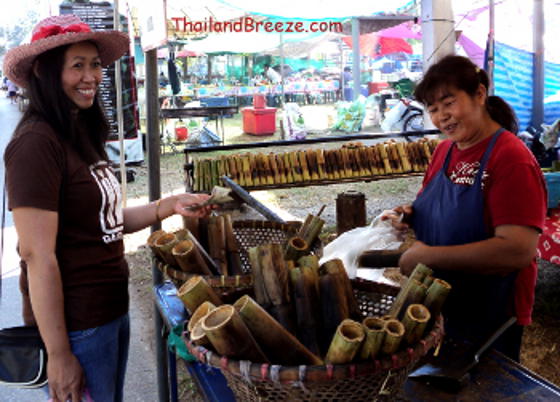Sticky Rice In Bamboo (Khao Lam)



Although sticky rice or glutinous rice is the staple food in the north and northeastern parts of Thailand, sticky rice desserts are popular all over the country. One of the most common desserts that you can easily spot is grilled sticky rice in bamboo.
Thais call the dessert khao lam. The word khao means rice and lam is a cooking method where you cook food in bamboo joints.
This dessert is made of sticky rice, boiled black beans, coconut milk, sugar and some salt, so it's also a nice treat for vegetarians. Normally, you have a choice of white and purple sticky rice. Once it has been cooked, the sticky rice at the top is soft and rich in flavor, while the bottom part is dryer and more chewy.

Some vendors include other ingredients such as taro, sesame and sangkaya (coconut egg custard) for variation. It's very rare that vendors add meat, except one that I know of, which is Mae Add in Nakhon Pathom.
Khao lam is simple to make, but time-consuming. First, the soaked sticky rice, boiled black beans and the mix of coconut milk, sugar and salt are put in the bamboo.

Many vendors cover the top of the bamboo joint with a big cork-like lid, made of banana leaf or coconut husk, so the ingredients won't spill out while cooking. Then, the filled bamboo joints are placed on a metal rack over hot charcoal for about an hour. They are turned occasionally for even cooking.

When you buy khao lam, the vendor cracks the bamboo for you, since it's not possible to open it by hand. However, in the north of Thailand, the khao lam often comes in soft bamboo stalks as the vendors remove the outer layer after cooking.
Thailand's Best Sticky Rice In Bamboo
Here are some places that are famous for their delicious sticky rice dessert in bamboo. Discover the original vendors and learn what is special about their khao lam.
1. Nongmon Market in Chonburi province (on the way to Pattaya and Bang Saen)
The name of the original vendor: Mae Muen
2. In front of Phra-Ngarm temple in Nakhon Pathom province
The name of the original vendor: Mae Add
Specialties: A variety of fillings such as taro, durian, lychee, and even green curry, basil leave and fermented fish
3. In front of Pu-Min temple in Nan province
The name of the original vendor: Mae Pyom
Specialties: Extra long bamboo joints and sangkaya (coconut egg custard filling). The bamboo is thin and can be peeled off
4. At Ratsada bridge in Lampang province
The name of the original vendor: Mae Chanta
Specialties: Sangkaya filling variations
5. Amphur Non Thai in Nakon Ratchasima province
Specialties: The black beans are replaced with peanuts
6. Near Wat Toong Kru in Bangkok
The name of the original vendor: Nai Goh
Specialties: Uses exceptionally fresh coconut milk

Other than those locations, the most common places to buy sticky rice in bamboo is at fairs, such as temple fairs, where all sorts of goods are sold in the outdoors. Otherwise, you may be able to find it at local markets or from vendors that drive around on motorcycles.
Sometimes the sticky rice has been sitting around for a few hours, so it's a good idea to check that it's still warm.
The khao lam has a nice blend of salty and sweet flavors. It tastes the best when freshly grilled, as it's really soft and warm. In addition, you still can smell the unique aroma of the grilled bamboo. Just make sure you don't eat too fast, since you can burn your tongue...
Although sticky rice or glutinous rice is the staple food in the north and northeastern parts of Thailand, sticky rice desserts are popular all over the country. One of the most common desserts that you can easily spot is grilled sticky rice in bamboo.
Thais call the dessert khao lam. The word khao means rice and lam is a cooking method where you cook food in bamboo joints.
This dessert is made of sticky rice, boiled black beans, coconut milk, sugar and some salt, so it's also a nice treat for vegetarians. Normally, you have a choice of white and purple sticky rice. Once it has been cooked, the sticky rice at the top is soft and rich in flavor, while the bottom part is dryer and more chewy.
Some vendors include other ingredients such as taro, sesame and sangkaya (coconut egg custard) for variation. It's very rare that vendors add meat, except one that I know of, which is Mae Add in Nakhon Pathom.
Khao lam is simple to make, but time-consuming. First, the soaked sticky rice, boiled black beans and the mix of coconut milk, sugar and salt are put in the bamboo.
Many vendors cover the top of the bamboo joint with a big cork-like lid, made of banana leaf or coconut husk, so the ingredients won't spill out while cooking. Then, the filled bamboo joints are placed on a metal rack over hot charcoal for about an hour. They are turned occasionally for even cooking.
When you buy khao lam, the vendor cracks the bamboo for you, since it's not possible to open it by hand. However, in the north of Thailand, the khao lam often comes in soft bamboo stalks as the vendors remove the outer layer after cooking.
Thais call the dessert khao lam. The word khao means rice and lam is a cooking method where you cook food in bamboo joints.
This dessert is made of sticky rice, boiled black beans, coconut milk, sugar and some salt, so it's also a nice treat for vegetarians. Normally, you have a choice of white and purple sticky rice. Once it has been cooked, the sticky rice at the top is soft and rich in flavor, while the bottom part is dryer and more chewy.
 |
Some vendors include other ingredients such as taro, sesame and sangkaya (coconut egg custard) for variation. It's very rare that vendors add meat, except one that I know of, which is Mae Add in Nakhon Pathom.
Khao lam is simple to make, but time-consuming. First, the soaked sticky rice, boiled black beans and the mix of coconut milk, sugar and salt are put in the bamboo.
 |
Many vendors cover the top of the bamboo joint with a big cork-like lid, made of banana leaf or coconut husk, so the ingredients won't spill out while cooking. Then, the filled bamboo joints are placed on a metal rack over hot charcoal for about an hour. They are turned occasionally for even cooking.
 |
When you buy khao lam, the vendor cracks the bamboo for you, since it's not possible to open it by hand. However, in the north of Thailand, the khao lam often comes in soft bamboo stalks as the vendors remove the outer layer after cooking.
Thailand's Best Sticky Rice In Bamboo
Here are some places that are famous for their delicious sticky rice dessert in bamboo. Discover the original vendors and learn what is special about their khao lam.
1. Nongmon Market in Chonburi province (on the way to Pattaya and Bang Saen)
The name of the original vendor: Mae Muen
2. In front of Phra-Ngarm temple in Nakhon Pathom province
The name of the original vendor: Mae Add
Specialties: A variety of fillings such as taro, durian, lychee, and even green curry, basil leave and fermented fish
3. In front of Pu-Min temple in Nan province
The name of the original vendor: Mae Pyom
Specialties: Extra long bamboo joints and sangkaya (coconut egg custard filling). The bamboo is thin and can be peeled off
4. At Ratsada bridge in Lampang province
The name of the original vendor: Mae Chanta
Specialties: Sangkaya filling variations
5. Amphur Non Thai in Nakon Ratchasima province
Specialties: The black beans are replaced with peanuts
6. Near Wat Toong Kru in Bangkok
The name of the original vendor: Nai Goh
Specialties: Uses exceptionally fresh coconut milk

Other than those locations, the most common places to buy sticky rice in bamboo is at fairs, such as temple fairs, where all sorts of goods are sold in the outdoors. Otherwise, you may be able to find it at local markets or from vendors that drive around on motorcycles.
Sometimes the sticky rice has been sitting around for a few hours, so it's a good idea to check that it's still warm.
The khao lam has a nice blend of salty and sweet flavors. It tastes the best when freshly grilled, as it's really soft and warm. In addition, you still can smell the unique aroma of the grilled bamboo. Just make sure you don't eat too fast, since you can burn your tongue...
1. Nongmon Market in Chonburi province (on the way to Pattaya and Bang Saen)
The name of the original vendor: Mae Muen
2. In front of Phra-Ngarm temple in Nakhon Pathom province
The name of the original vendor: Mae Add
Specialties: A variety of fillings such as taro, durian, lychee, and even green curry, basil leave and fermented fish
3. In front of Pu-Min temple in Nan province
The name of the original vendor: Mae Pyom
Specialties: Extra long bamboo joints and sangkaya (coconut egg custard filling). The bamboo is thin and can be peeled off
4. At Ratsada bridge in Lampang province
The name of the original vendor: Mae Chanta
Specialties: Sangkaya filling variations
5. Amphur Non Thai in Nakon Ratchasima province
Specialties: The black beans are replaced with peanuts
6. Near Wat Toong Kru in Bangkok
The name of the original vendor: Nai Goh
Specialties: Uses exceptionally fresh coconut milk
 |
Other than those locations, the most common places to buy sticky rice in bamboo is at fairs, such as temple fairs, where all sorts of goods are sold in the outdoors. Otherwise, you may be able to find it at local markets or from vendors that drive around on motorcycles.
Sometimes the sticky rice has been sitting around for a few hours, so it's a good idea to check that it's still warm.
The khao lam has a nice blend of salty and sweet flavors. It tastes the best when freshly grilled, as it's really soft and warm. In addition, you still can smell the unique aroma of the grilled bamboo. Just make sure you don't eat too fast, since you can burn your tongue...
